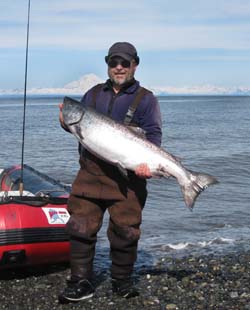Volunteer Spotlight:
John Kennish, chair of the council’s Scientific Advisory Committee, also known as SAC, found his life’s calling early.

“I knew I’d be a chemist in the 11th grade when my teacher told us how scientists first figured out the composition of water,” Kennish said. “What excited me was how you could take indirect evidence and use your own sense of logic to draw conclusions about what was really occurring.”
“I thought that was awesome.”
Kennish grew up in small town in New Jersey. His hometown was a rural community of around 2000 people. He worked on farms, fished and collected mushrooms. When he left to attend graduate school, he only applied to colleges in the Pacific Northwest, because that area had the best fishing, he says.
Fishing is also what inspired Kennish to start looking for work in Alaska after earning his PhD in Environmental Analytical Chemistry from Oregon’s Portland State University in 1978. He was hired by the University of Alaska in Anchorage to teach chemistry, and has been there ever since.
Kennish was recruited as a volunteer for the council by SAC member Roger Green and former council staffer Lisa Ka’aihue in 2004. He was elected chair of the committee in 2008.
Since the council’s inception, the committee has managed a project to monitor the level of hydrocarbons from crude oil in the Sound. One difficulty the monitoring project has always faced is that there was very little environmental data to show what the water quality conditions were like in Prince William Sound before the 1989 Exxon Valdez oil spill.
Kennish says if his advice had been taken, it wouldn’t have been that way. About ten years before the spill, Kennish and then fellow UAA professor John French wanted to test the waters of Port Valdez for hydrocarbons. At that time, the terminal’s ballast water treatment facility that cleans the oily water from the ballasts of tankers discharged an estimated average of two barrels per day of oil and grease into Port Valdez every day.*
“When I look back, we were ahead of the curve on that one,” Kennish said. “We would have had that baseline data.”
Kennish and French went ahead with a modified version of the project, but results were limited because they were refused access to the terminal to collect samples.
Many of Kennish’s research projects have involved looking at the effects of toxic materials in the marine environment. Most recently, Kennish has been studying the effects of phthalates on trout and salmon. Phthalates are what makes plastic flexible. The substance is easily released into the environment as plastic degrades. Scientists are suspicious that phthalates in the environment are having a negative effect on the health of various species, including humans.
Kennish and his collaborator, Patty Zwollo a biology professor at The College of William and Mary, are testing phthalate levels in Elizabeth Lake on the Kenai Peninsula. Waves from the Gulf of Alaska push marine debris into the lake where it collects on the shore.
Kennish thinks this project could possibly answer questions about declining wild salmon runs in recent years.
Read more about Kennish’s project here: http://bit.ly/PhthalatesAndSalmon
Kennish’s expertise has been a valuable asset to the council over the years. The council has long been concerned about the effects of crude oil, and the mix of crude oil and dispersants.
“Dispersants are a problem because they increase the toxicity of oil,” Kennish says.
“You’re not really removing the oil, you’re just spreading it out, so it affects the environment in a different way,” said Kennish. “We still don’t know all the effects.”
Kennish says the science committee has been looking into how to evaluate the low-level chronic impacts of oil and dispersed oil. They are trying to determine a good biological indicator, a species that can be monitored to determine the health of the environment, which would not be prohibitively expensive to monitor.
To read more about the council’s hydrocarbon toxicity projects, visit our website: www.pwsrcac.org/programs/environmental-monitoring/hydrocarbon-toxicity/
“My time on the Scientific Advisory Committee has been one of the most significant contributions I have made to the State of Alaska,” Kennish said. “The members of this committee are very dedicated and hardworking and are well respected.”
“Working as a volunteer for the council is a wonderful opportunity and a great experience because the organization is surprisingly well managed and has very clear and positive goals for carrying forward the intent of the Oil Pollution Act of 1990 and in continuing to protect Prince William Sound.”
* Today, due to lower pipeline throughput, improvements in operation of the ballast water treatment facility and the reduction of oily ballast coming to the terminal due to the phase-out of single hull tankers, the facility puts out about one gallon per day of oil and grease.